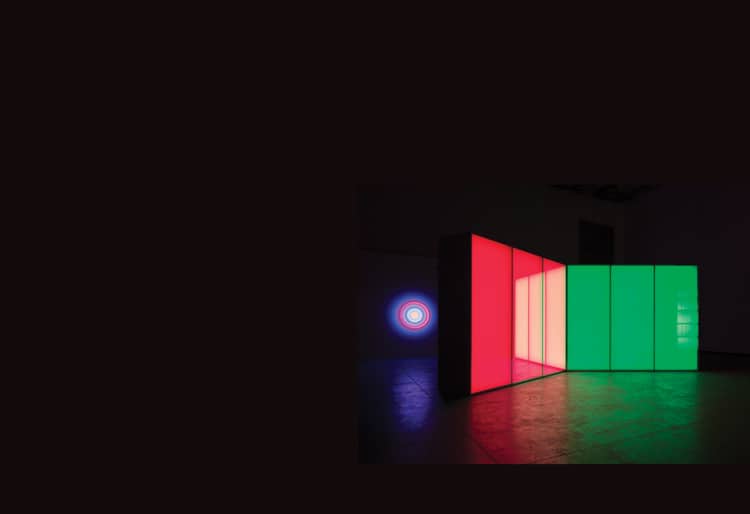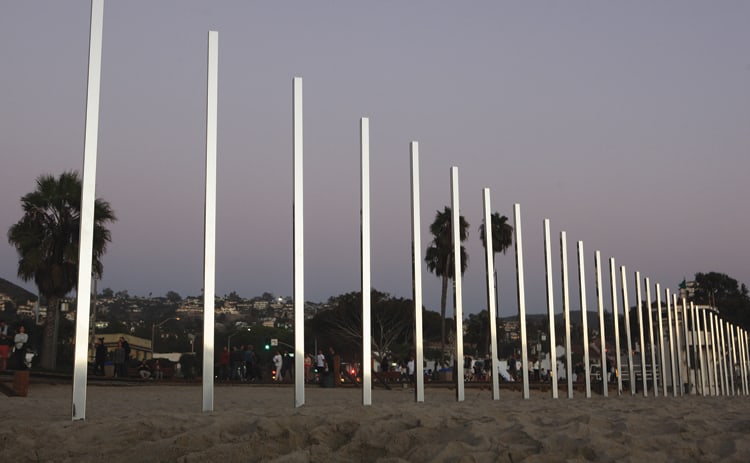
“Lucid Stead,” Installation view in Joshua Tree, CA, 2013
Existing 1940s homesteader shack, mirror, LED lighting,
and custom electronics, 14’2″ x 20’3″ x 9’6″
Photo: Steve King, courtesy: the artist and Royale Projects, Los Angeles
A modern tabernacle rises from brown desert sand, glowing with an ethereal, science fiction-inflected pageant of color, field, and sky; a jackrabbit homestead wears a mirrored cloak that renders it almost invisible when the sun and horizon perform their choreography; an intimate dark room reveals itself infinitely larger on the inside, as suffuse colored light bends the rules and optics of physical space; a bunch of tripping hipsters get their minds totally blown by a temporary temple to cushy magic-hour light between sets at Coachella. All of this and more is the spectacular handiwork of sculptor and installation artist Phillip K. Smith III (aka PKS3), a denizen of the high desert whose unique relationship to architecture, the landscape, and the Light and Space movement has yielded some of the most intriguing interior installations, public sculptures, and ephemeral Land Art in recent memory. From Joshua Tree to Indio to Laguna Beach, and now as part of the inaugural edition of Desert X this winter, Smith has quickly become one of the most sought-after and emblematic artists of the current intertwined interests in art from the Los Angeles region, issues of the desert climate, and the resurgence of the land art genre in general.
A resident of Palm Desert, and artist-in-residence at Palm Springs Art Museum in 2010, Smith first came to broad attention in 2013, after his Lucid Stead project—a small remote cabin whose mirrored exterior reflected the empty world around it by day while its interior emanated an otherworldly light show by night—went viral. At the time, Smith’s deepening relationship to the desert was longstanding, in both personal and aesthetic ways. The desert’s allure he considered as the content, muse, and setting for his meditations on the spectrum of colors of the earth, its particular qualities of the light and sky. But his recent ever-increasing involvements with both ocean and city, as well as his developments in interior immersive and free-standing works, speak to a more conceptual framework rooted not only in his early life, but in his professional background in architecture. “Crafting a spatial experience that converses with a sensitive, contextual response to the environment is at the core of my thinking,” Smith explains. “There’s an understanding of the movement around, through, and within the work; of interacting with the environment and defined space via light, surface, form, and materiality…” as well as economies of scale and mechanisms of constant change based on his experiences in the landscape—the poetic drama, say, of the curving, crisp line of a sand dune’s edge fading to a pure plane of color.
“Getting out into the landscape is important to me,” notes Smith. “I desire to be confronted with a very real, overwhelming beauty that challenges the understanding of my own work and the potential that exists.” Most recently, Smith has been engaged in a dialogue between the ocean and the desert, two ecologies that are deeply related in terms of the region’s cultural and geological history. Apparently, you can still find seashells in certain parts of the Coachella Valley desert and the evidence of the prior sea level line can be seen on some of the mountains in the East Valley. The sands of the beach and the sands of the desert are in a constant state of change. Both environments deal directly with a strong horizon line, creating what Smith loves the most: “The distinct meeting of a horizontal plane with an expansive space. And within that moment, there is an equal understanding of finite and infinite space. I’ve created projects for a number of environments. In the end, I’m interested in opening people’s eyes to the beauty that exists around them by actually using the environment as material within the work.”
Glass, aluminum, LED lighting, and custom electronics, 96″ x 258″ x 106″
Photo: Lance Gerber, courtesy: the artist and Royale Projects, Los Angeles
Smith’s recent show at the Laguna Art Museum this fall, combined with the 1/4 Mile Arc temporary installation that he executed along a stretch of local beach there, deals with the expansion and compression of ideas and experiences. Through tracing a pure arc of sculptural elements that followed the natural geometry of the beach, he was able to “harness the sunset” via an aggregation of reflective, ordered samplings of the sky. Focusing on one of those samplings and the gradients that exist within that vertical reflection directly inspired the color shift that exists within Torus 9 (a major work, installed inside LAM). Merging ideas of color and reflection, the related Bent Parallel focuses the eye on the dialogue of two color planes and how their meeting can create a third, material-less, zero-thickness plane of color through a structure of geometry and reflection. This experience of shifting scale, of the intimate and the infinite, of memories created, is as key within Smith’s work as any of its physical or optical elements.
Watch for Smith’s thoughts and evolutions expanding on the in situ experiments begun in Laguna to be further explored in Palm Springs, as Smith has described his plans for the forthcoming Desert X festival as “looking to bring the dialogue that I established with the horizon line of the ocean, to the horizon line of the desert.” Of course, even creating a work that is 20 x 20 x 20 feet is quite small within the context and size of the desert, where epic scale is a requirement. And Smith is the first to admit that land art is challenging. It’s logistically difficult. It requires approvals and permits and drawings and dealing with people that have zero interest in art. But Smith says he actually relishes those kinds of challenges. “I like being thrown into a room of people that never talk about art and coming to an understanding of how we can achieve something together. And to be clear, so many artists believe that such processes can only result in compromise and a watering down of the original concept. I could not disagree more. What I’ve found on every large-scale project I’ve created is that people want to be part of something important and memorable. And that through the process, attitudes change and eyes and ears are opened. Now that 1/4 Mile Arc has been achieved, what else is possible? By pushing the boundaries and understanding of art in atypical environments at atypical scales, the door can be opened for other artists seeking great, visionary projects.”
Photo: Eric Stoner, courtesy: Laguna Art Museum
But the folks in charge of curating Desert X are anything but art-world outsiders, and the show boasts an eclectic roster of artists who are themselves vigorously embracing, or at least, being prompted to navigate, both the process and the place, some as veterans and many for the first time. “For me,” Smith says, “it’s been exciting to dialogue with the Desert X artists to see how they interpret the regional landscape from an outsider’s perspective. This is the environment that I am immersed in and that I find inspiration in on a daily basis, so I’m looking forward to seeing how an East Coast, European, or South American mindset recalibrates within this environment.” Smith has participated in previous festival-style desert-centric events, differently conceived and slightly smaller-scale projects like High Desert Test Sites and the first edition of the Joshua Treenial (the second of which opens in March), which in some ways are the precursors to Desert X, and in some ways offer an arguably more contemplative, intimate alternative to Desert X’s massive aesthetic and presence. And indeed, Smith is not alone in asking the kinds of questions many have about Desert X. To what degree will the works speak to the core of the desert experience of time, change, and history? Will the artists submit to the desert climate, or fight to tame it? How will interactions with the landscape affect not only the artists’ but also inevitably the viewers’ own experiences? There are environmental factors at work which artists like Smith can perhaps anticipate, but not control.
When it comes to crafting a more managed and manageable experience, Smith is also expert at the subtle but total transformation of interior spaces. In both immersive, walk-in spaces and through the operations of simple self-contained wall-mounted sculptures, Smith deftly manages to translate his affection for pure color, malleable light, their effects on architectural and emotional perception, and a hint of awe-inspiring, instagram-flooding theatricality into less arduously accessed works of art. For example, his Los Angeles gallery Royale Projects has installed a reconfiguration of the elements from the now-dismantled Lucid Stead into a semi-permanent room-size installation in the gallery’s downtown arts district location. Where much of Smith’s work literally absorbs elements of its surroundings into its composition and content, rather than playing with horizons and changes in natural atmospherics, his interior works play with deracinated aspects of depth and shape. Reviving the classic aims of Light and Space, Smith’s indoor voice renders seeing as a physical action, and optics as a matter for the body as well as the mind, one that ought not be taken for granted. Its syncopated changes, and the multichannel phasing ensure it never repeats exactly. Pure color fields with no image content, these narratives are phenomenological rather than informational. Their spacetime is suspended, anchored to neither sand or horizon. Expect magic, no off-roading required.

